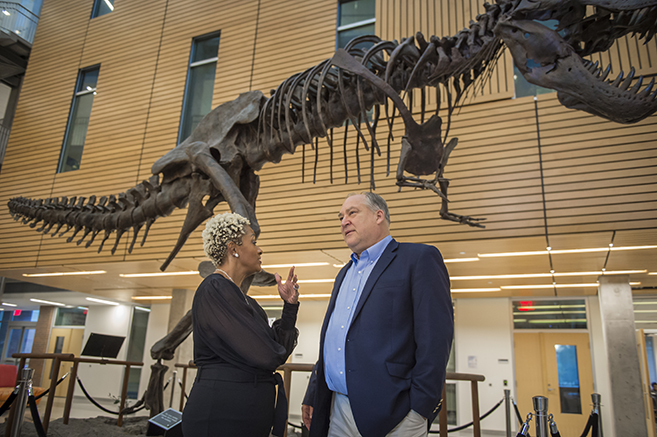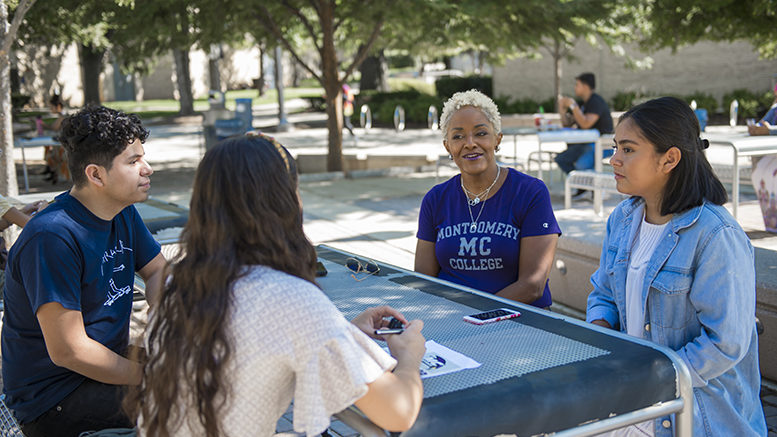At Montgomery College (MC) in Maryland, diversity isn’t just an item to check off on a checklist of values.
“When we start thinking about the glorious diversity of our student body, it’s one thing to count people, it’s another to add values to their experience,” said DeRionne Pollard, who recently celebrated her 10th anniversary as president of the community college.
Seven years ago, Pollard pioneered the idea of radical inclusion, defined in a board of trustees statement as “deeply rooted values of welcoming all individuals who seek higher education or continuing education… an essential element of our identity.” The three-campus college is marking its 73rd year.
“Our college works around the idea that all members of the community deserve the right to postsecondary education,” Pollard says.
Montgomery College’s efforts have caught national attention. In 2018, MC ranked as the most diverse mainland community college in the nation in a survey by the Chronicle of Higher Education. For the fall semester, 78 percent of MC students are non-white, and 26 percent of the total are Black.
In 2015, MC received an American Association for Community Colleges Award of Excellence in the Emerging Leadership category, and the following year the college received the award in the Outstanding College/Corporate Partnership category.
Help for minority students
To recruit and help minority students, Montgomery College is part of a college prep program, ACES (Achieving Collegiate Excellence and Success). It’s a collaborative effort with Montgomery County Public Schools and the Universities at Shady Grove, part of the state university system.
“We post coaches in a targeted high school with large populations of students who are quote unquote at risk,” Pollard says. Those include students who are Black, brown, first-generation college applicants, or who have physical or emotional difficulties.
“Our job is to coach students and families through their high school and undergraduate work at Montgomery College and our university partners at Shady Grove,” Pollard says. The college helps fundraise for scholarships for the students.
“These are some of the most effective programs we have,” she says. They have helped 2,000 students.
Equity and inclusion
In May 2017, the college hired its first chief equity and inclusion officer, Sharon Bland. In November, Pollard asked the college to create the President’s Advisory Committee on Equity and Inclusion. So before the current national discussion about systemic racism, MC had already built a roadmap to help members of its community respond, Pollard says.
Pollard has also worked to recruit and support immigrant students.
“We are very fortunate to live in a community that is very diverse in itself,” Pollard says. “Montgomery County attracts immigrants. We have students from 160 countries. In a lot of ways, we are making manifest this notion of what community colleges are.”

When the Maryland Dream Act was passed in December 2012, it allowed state high school graduates who are undocumented immigrants to qualify for in-state tuition at public colleges if they meet certain eligibility requirements, including first graduating from community college. Pollard supported Dreamers wholeheartedly and persuaded the board of trustees to do the same. Undocumented county high school graduates were offered in-state tuition at Montgomery College before the state law was passed.
Pollard is very aware that money can be an obstacle for students.
“Poverty is the number one barrier to college completion,” she says. “We’ve been very deliberate about fundraising to provide scholarship opportunities.”
Sometimes that’s especially important for immigrant students.
“A lot of students come from countries where education was seen as a right of the privileged,” Pollard says.
MC does not limit its outreach just to high schools. It sends instructors to the county jail so inmates can take courses toward a college degree. Recruiters also go to a public library in a part of the county with many immigrant families to help them navigate the college application process. Some families need help with computer access. The college also has worked with an Ethiopian community center, which helps to serve the county’s large Ethiopian population.
Helping with food insecurity
“We were one of the first institutions this spring to make a decision about our commencement,” Pollard says. As commencement went online, “we decided to reallocate $900,000 to students” to help supply food, household supplies such as detergent, and access to technology.
The college partnered with the Capital Area Food Bank to create mobile markets, which had three events that served more than 2,000 students. During the pandemic, 47 percent of Montgomery College students have reported food insecurity. This fall, the college also will help students get flu shots, Pollard says.
Pandemic principles
In mapping its response to the coronavirus pandemic, MC has used two guiding principles.
“We treat our students as learners,” Pollard says. That means their classes need to be scheduled in a way that fits students’ needs, and they need to stay connected as much as possible. Counseling, though it may be online, is especially important now.
“We also treat them as consumers,” she adds. “They have an option. We made decisions about summer in late April and about fall in early May. We recognize our students’ lives are complex, so it was important to get information out early.”
Before the pandemic, the college offered five degrees online. This fall, 95 percent of classes are remote, synchronous classes. The college invested in intensive faculty training, Pollard says.
MC was able to provide money to help some students buy laptops. For internet access, students have made creative use of the county’s robust wi-fi availability, Pollard says.
“Many sit on campuses, in parking lots or outside spaces” to log on to class websites.
To stay connected with the college community, Pollard sends a video or other communication one to three times a week.
“I’m often replying to messages I receive,” she says. “A student said, ‘I’m not on social media. You keep me grounded.’”
Anchor institutions
Pollard believes strongly that community colleges are anchor institutions during the pandemic.
“We are barometers of the health of the community,” she says. “If the community is doing well, the college is doing well, and vice versa.
“I tell my counterparts in four-year colleges, ‘Your students are there seven months a year, then they go home. My students live here.’”

